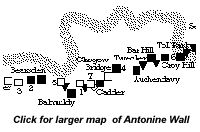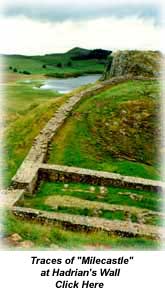
The Roman invasion of Britain began in the year 55 BC. Over the next hundred years or so, the Legions consolidated their positions until they dominated almost all of modern-day England.  Called "Britannia" this new territory was considered a valuable addition to the Roman Empire because it was rich in minerals and the land was fertile, providing the empire with a new western breadbasket. Called "Britannia" this new territory was considered a valuable addition to the Roman Empire because it was rich in minerals and the land was fertile, providing the empire with a new western breadbasket.There was only one problem and that was unconquered territory to the north, Caledonia, or modern-day Scotland. This territory contained native Celtic tribes, which were strongly anti-Roman, and the remnants of defeated tribes which could not accept Roman rule. In retaliation, these tribesmen would raid and harass Roman outposts and ambush patrols.
To suppress this area, an army was assembled and went north under Agricola in 77 or 78 AD. Through a series of mainly summer campaigns, Agricola managed to capture a large portion of modern Scotland.
The Antonine Wall was thirty-seven miles long, half the length of Hadrian's Wall, and extended from between the Firth of Forth and the mouth of the River Clyde. The II, VI and XX ROMAN Legions constructed the Wall in sections around 142 AD. It consisted of a foundation of stone 14 feet wide upon which was placed dirt and turf. In front of the wall there was a deep ditch 40 feet wide and behind it ran a military road connecting its 18 small forts and the signaling towers between them.
This new wall was intended to be permanent, its shorter length allowed a doubling of the garrison in comparison with Hadrian's Wall. But within 10 years there were problems with the new wall. Forts along the old Hadrian's Wall were re-occupied, and there were new hostilities among the Romans and the Pictii. Some suggest that the Picts just climbed in boats and sailed around the wall to raid the Romans. It is also possible that the new people of the land threatened the Romans, the Scots, who were colonizing the lands north and west of the Antonine Wall. This alliance of forces between the Scots and the Picts may have been enough to scare the Romans back to their heavier defensive line, Hadrian's Wall. From 154 to 157 AD, the Antonine Wall was breached on many occasions. The Pictii and their allies continually harassed and attacked the Romans whenever possible. This eventually led to the wall's abandonment around the year 157 or 158 and the Roman withdrawal from southern Scotland in 164 AD.
by BW, January, 2000 Special thanks to Professor Terence Odlin, for the use of his pictures of the Antonine Wall and Hadrian's Wall Special thanks to Peter Green, webmaster of Britannia: Gazetteer of Roman Military Sites in Britain and Bibliography of the Roman Military History of Britain, for the use of his map of the Antonine Wall. Suggested Reading: The Oxford Illustrated History of Roman Britain, by Peter Salway, Oxford University Press, 1993 Kingdoms of the Celts, by John King, A Blanford Book, 1998 Lost Kingdoms: Celtic Scotland and the Middle Ages, by John L. Roberts, Edinburgh University Press, 1997 Links: Britannia: Gazetteer of Roman Military Sites in Britain Prof. Terence Odlin: The Antonine Wall and Hadrian's Wall The Antonine Wall in Scotland: Athena Review Sections of the Antonine Wall and Hillfoot Cemetery: Athena Review The Romans in Scotland: University of Glasgow
|
Thursday, December 26th, 2019
Attention visitors: Tartans.com is back. Please note that this is a snapshot of the site as it existed nearly 20 years ago and you may encounter broken links; we are still combing through the site and correcting those as we find them. Please also note that some sections are currently not functional, primarily the discussion forums/clan chat boards.
|
** HOME - First Time Visitors - Glossary - - Contact Us ** Awards | Bibliography | Clan Calendar | Clan Chat | Clan Finder | History | Famous Scots | Genealogy | Great Hall of the Clans | Links | News and Features | Scots on the Net | Search | Site Map The Gathering of the Clans
Copyright 1995- Tartans.com - All Rights Reserved. |



